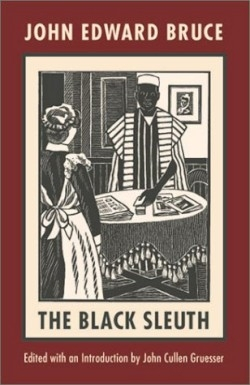The Black Sleuth
You just can’t elude Sadipe Okukenu. The African investigator dominates this nineteenth-century detective story, which offers a bold diatribe against racism. Physically glorious and intellectually and morally superior to the characters he encounters, Sadipe looms larger than life, and the text can barely embody him. The story was originally printed as a serial in McGirt’s Magazine in the early 1900s. The author, born a slave in Maryland, worked as a journalist, editor, historian, and public speaker, and co-founded the Negro Society for Historical Research. His story is now being published for the first time in novel form. The editor, Professor of English at Kean University, has previously published a book on Black writers’ works about Africa.
The opening of Bruce’s story promises a lavishly European tale—mystery, mayhem, romance, and cross-continental travel to recover a stolen diamond. Bruce weaves his text with clues that none-too-subtly demonstrate the absolute humanity of the Black race. By painting Sadipe Okukenu with god-like strokes, he deftly inverts the notion that persons of African descent are merely savages who need the civilizing forces of whites. Before meeting Sadipe, readers are introduced to his older brother, Mojola. Though “splendid” in every way, Mojola is not unique among his people. The magnificent Sadipe, then, comes as no surprise. Bruce broadly hints that there are whole nations of Sadipes and Mojolas, and it is their ancestors who were sold as slaves in the Americas.
Sadipe’s noble stance is inextricably linked to Blacks in America, and by having Sadipe resist racism in America, Bruce allows him to reclaim the dignity of his entire race. Through the detective, the author tells a shocking tale of institutionalized and legalized racism, and through Sadipe’s example, offers the promise that Blacks can and should appropriate his bearing. Then Sadipe goes off to London on the trail of the stolen jewel. The loss and discovery of the diamond, narrated in the final third of the novel, is secondary to the political message underpinning the tale.
The reader as sleuth discovers Sadipe’s honorable identity and superior skill, and cannot help but wonder that such qualities of character may well belong to all persons of his ethnicity. The story ends abruptly, perhaps a symptom of its earlier life as a serial. Yet its strained ending works. Sadipe is on the trail of European criminals to recover the diamond, and although it is doubtless that he catches the culprits, the reader never witnesses the capture. One must, however, catch Bruce’s point: what does dominant culture do in a text and a world that can barely sustain the Sadipe Okukenus?
Disclosure: This article is not an endorsement, but a review. The publisher of this book provided free copies of the book to have their book reviewed by a professional reviewer. No fee was paid by the publisher for this review. Foreword Reviews only recommends books that we love. Foreword Magazine, Inc. is disclosing this in accordance with the Federal Trade Commission’s 16 CFR, Part 255.

